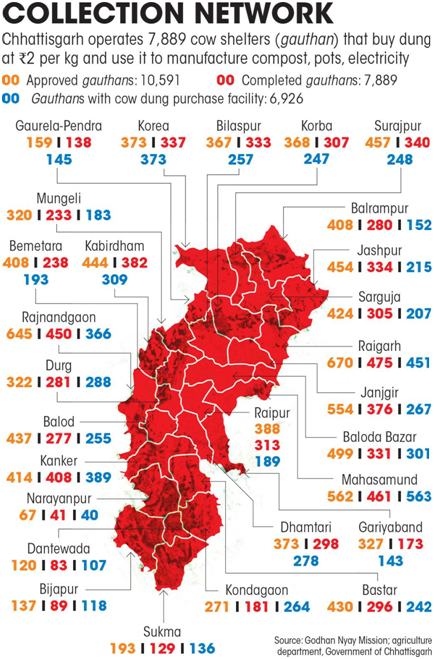

Context
Chhattisgarh’s flagship economic model, that started as cow dung procurement & organic fertiliser production scheme in 2020 is helping state give rural economy and women empowerment, a push.
Background
- Chhattisgarh’s flagship economic model began as a cow dung procurement and organic fertiliser production scheme in 2020.
- The state government aimed at providing income support to farmers, while also addressing a shortage of chemical fertilisers in the state.
- The model is currently in its third phase, which is pushing self-help groups (SHGs) involved in the scheme towards entrepreneurship
- The first two phases were procuring cow dung and setting up cattle-care centres — called gauthans — and their expansion into rural industrial parks.
- In this mission, rural women associated with the state’s SHGs are at the forefront.
- This scheme was awarded the Elets Innovations Award at the national level in 2022 in the category of innovation in agriculture.
- It received the 'Skoch Gold Award' for its outstanding contribution to environmental protection and sustainable development in 2022.
Analysis
Chhattisgarh’s ‘gobar (cow dung) economy’. />
/>
Different Phases of the Scheme
1st Phase - ‘GodhanNyayYojana’- Under the scheme,
- GauthanSamitis will procure cow dung at Rs 2 per kilogram from livestock owners and use it to prepare organic fertilizers
- Women self-help groups will repurpose procured cow dung into vermicompost and other eco-friendly items
- Cooperative societies will sell vermicompost at Rs. 8/- per kg to the farmers to promote organic farming
- This is much cheaper than chemical fertilisers, priced at Rs 48 to 50 a kg.
- Distribution of vermin-compost fertilizer to farmers will be done as a commodity loan by cooperative societies, and banks
How the GodhanNyayYojana is helping the rural economy?
- This is a part of the larger perspective of going back to villages, reviving the rural economy and generating sustainable rural livelihood, as 80 per cent of the state’s population lived in villages.
- helping generate additional income and increase employment opportunities, especially for women
- preventing open grazing and straying of cattle on streets
- encouraging use of organic fertilisers and minimise use of chemical ones
- helping enhance fertility of crops and availability of chemical fertilizers, which will further enhance the nutrition level of crops
- with protection of crops and reduced cost of cultivation, it is helping increase acreage
- encouraging dairy and animal husbandry and increasing milk production
- Plans are also afoot to diversify the cow dung product range by manufacturing items like paint, phenyl and gaukasht (cow-dung log, used in funerals).
- Enhancing confidence: Getting women into the public space is important. It affects their confidence and their psychology.
2nd phase - Chhattisgarh GauthanNirman Scheme:
- Gauthans have been constructed under Narva, Garwa, Ghurva, Bari (NGGB) scheme
- gauthans are sheds where cattle could be kept for the day and looked after
- The cow dung collected here would then be sold to the government
- These gauthans gradually started housing vermicompost pits
- Employees included women from SHGs in the villages in which the gauthans were located.
- Various activities like poultry farming, broom making, idol making work are being carried out under one roof along with the sale of compost manure
- Gauthans produce raw materials, like herbal extracts, which are then used in making things like soaps and perfumes.
- While some women have started their own businesses at the gauthans, others work for a fixed wage that the SHGs payout.
- On average, the gauthans provide eight hours of fixed daily work to about 30-40 women in the villages where they’re set up
According to the government policy, the land and infrastructure for the setting up of the gauthan come from the local gram panchayat, which buys the land and then ensures that it has adequate water supply, sheds for cows, pits for vermicompost etc.
- The state administration plays a crucial role in terms of first identifying a strip of land large enough to serve its purpose.
- District officials convince gram panchayats to use monetary grants and other funds to set up the gauthans
- Government figures peg the number of operational gauthans in Chhattisgarh at approximately 8,400.
 />
/>
3rd Phase - Rural Industrial Park
The state government is now in the process of transforming these gauthans into ‘rural industrial parks’, or centres for cottage industries that the government hopes will create retail products that can “compete with the market”
The aim is to increase economic activities in rural areas and empower the rural populace to create avenues of income for themselves
- A rural industrial park is essentially a large area that is expected to house cow sheds, vermicompost pits, and infrastructure for cottage industries like vegetable farming, perfume-making, pisciculture, poultry-farming, textile work, and more.
- It is meant to be like a co-working space for women in SHGs who want to run their own businesses.
- The parks are also supposed to be centres where villagers can be trained in the skills required to run such businesses and create such products.



